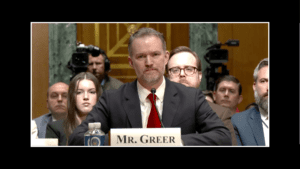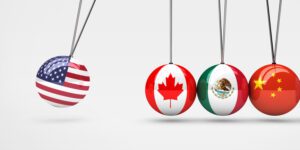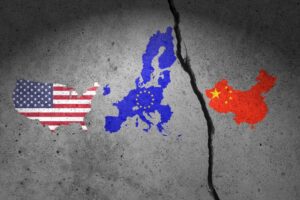Video: Nomination Hearing of Jamieson Greer to
be United States Trade Representative

|
On Thursday, February 6, 2025, the U.S. Senate Committee on Finance held a hearing to consider |
|
What Just Happened: New Tariffs on Products
from Mexico, Canada, and China


|
On Feb. 1, President Donald Trump issued three executive orders concerning a “public health crisis” regarding the influx of illicit drugs to the United States from Canada, Mexico, and China. The orders reiterate the national emergency the president declared on his first day in office regarding the “grave threat to the United States posed by the influx of illegal aliens and illicit drugs” and expand the scope of that emergency. As required by the underlying statutes on which the president relies, the orders refer to alleged “failure[s]” of these other governments to stop the drug trade as “an unusual and extraordinary threat.” The orders also announced that goods from these three countries would be subject to tariffs at varying levels beginning Feb. 4 at 12:01am. On Feb. 3, the leaders of Mexico and Canada each spoke with the president. Following those calls, the Trump administration announced a 30-day suspension of the tariffs on products from Mexico and Canada in light of promises made by each leader (some of which were promises that they had made already in 2024) to shore up their border protection and related efforts. On Feb. 4, China announced retaliatory measures against the United States in the form of tariffs on certain U.S. products, as well as export controls among other regulatory interventions. What Has Been the Effect? The U.S. foreign commerce bureaucracy – in this instance, namely the International Trade Commission and Customs and Border Protection (CBP) – moved swiftly to take steps to arrange to charge importers additional taxes on the goods they bring in to the United States from these three countries, although now only the restrictions related to products from China will remain in place. Products from China will face a 10 percent levy on top of any other tariff to which they would be subject. If the Trump administration decides to lift the suspension and re-impose the measures on Canada and Mexico, then all products from Mexico and most from Canada will be subject to a 25 percent levy. Energy products from Canada will be subject to a 10 percent levy. (Recall that, as a result of the United States- Mexico-Canada Agreement (USMCA) – the free-trade agreement negotiated by the Trump administration in 2018-2019 – most products presently enter the United States from these two countries with no such charge.) |
|
02/05/2025 | Kathleen Claussen | Just Security |
Toward a Cleaner, Smarter USMCA


|
C.J. Mahoney and Peter Harrell are featured speakers on Day 1 of the 2025 Washington International Trade Conference, on February 10. More information can be found here. By July 1, 2026, the parties to the United States–Mexico–Canada Agreement (USMCA) must confirm in writing whether they wish to extend its term. Otherwise, a clock will start to tick toward the termination of USMCA at the end of its original sixteen-year term in 2036. U.S. President-elect Donald Trump already has said he plans to push for changes to USMCA, and given his recent, pre-inauguration threats to impose new tariffs on Mexico and Canada, it’s likely talks between the three North American countries will begin early in 2025. While much of the negotiators’ time no doubt will be spent relitigating historic trade grievances, the renegotiation also offers opportunities to strengthen the North American industrial base. The renewal deadline approaches at a time when the governments of all three USMCA countries are concerned about the strength and resiliency of supply chains, particularly with respect to the minerals and products that are needed to pursue “all of the above” strategies that will boost both renewable and traditional technologies for U.S. energy, transportation, and manufacturing. If these concerns can be channeled into shared negotiating objectives, the USMCA renewal could offer an opportunity to enhance North America’s competitiveness—and to do so on a fast timeline. Few challenges haunt trade negotiators more than a lack of meaningful deadlines. This has been especially true for agreements that lie at the intersection of trade and environmental policy. Defenders of the status quo have a good record of killing such agreements by running out the clock. Negotiations over the plurilateral Environmental Goods Agreement petered out after multiple rounds of talks. In 2022, members of the World Trade Organization completed an agreement on subsidies for ocean-depleting fisheries after years of negotiations, but only after the United States and other subsidy critics conceded that some of the most problematic subsidies could remain in place. There were high hopes for negotiations between the United States and the European Union (EU) regarding an agreement on low-carbon steel and aluminum during President Joe Biden’s administration, but when negotiators missed an USMCA’s pending renewal deadline offers policymakers a rare opportunity to change the typical negotiating dynamics. The governments of the United States, Mexico, and Canada should seize it to align on efforts to strengthen the North American industrial base by developing proposals to reshore the continent’s rare earth and critical minerals supply chain, adopt common rules and standards for carbon-intensive products, and increase clean power generation and grid capacity. They might also use this occasion to recruit other partner and allied governments to this cause by expanding membership in USMCA. If this effort is successful, the result could be a more competitive, resilient, and cleaner North American economy. If it fails, the best—and perhaps only—chance in this decade for the United States to use trade policy to advance sustainability and industrial policy goals will have been lost. |
|
12/17/2024 | C.J. Mahoney & Peter Harrell | Carnegie Endowment for International Peace |
Meeting China’s Trade and Tech Challenge:
How the US and Europe Can Come Together


|
For more than two decades, China has worked to free itself from dependence on Western technology while making the West dependent on Chinese products. It protects priority industries and subsidizes them into becoming export juggernauts. China engages in economic coercion. Its civil-military fusion strategy powers a significant buildup of its military, surveillance, and disruptive capabilities. Its aggressive territorial claims in the South and East China Seas, and its threats to Taiwan’s integrity, present real risks of military conflict. Beijing and Moscow’s declaration of a “no limits” strategic partnership, and China’s active support for Russia’s war on Ukraine, threaten US and European security, interests, and values. Although the transatlantic partners are closer in their assessments of the China challenge today than they were four years ago, they approach Beijing from different strategic positions, with different tools, and with different senses of urgency. They have allowed their own bilateral squabbles to get in the way of robust transatlantic efforts to address Chinese aggression. These simmering problems could boil over in 2025. …A joint approach to China should be guided by three Ds: deconflict, disentangle, and deny. The US and Europe should deconflict their own bilateral ties so they do not endanger transatlantic cooperation on China. They should disentangle their economies from uncomfortable dependence on China. And they should deny critical technologies, data, or goods to China that could advance Beijing’s military capabilities and revisionist goals. To deal with China, the transatlantic partners first need to deal with each other. A transatlantic accord could include European commitments to boost defense spending to 3% or more of gross domestic product by the end of the decade; bolster support for Ukraine; diversify from Russian energy; buy more US-produced liquified natural gas and other energy exports, agricultural products, and defense equipment; and refrain from levying unilateral digital services taxes on US firms. The US, in turn, could commit to maintain an active role in NATO, ensure Ukrainian security and sovereignty, refrain from imposing preemptive tariffs, and explore effective global tax reform. |
|
01/23/2025| Daniel S. Hamilton | Center for European Policy Analysis |
Managing the Risks of China’s Access to U.S. Data
& Control of Software & Connected Technology


|
On January 20, 2025, the first day of his second term, President Donald Trump sought to delay enforcement of a 2024 law that banned distribution of the popular Chinese-owned social media app TikTok. The intent of this delay was for his administration to work out a deal by which TikTok’s Chinese parent, ByteDance, could divest the app. Regardless of the ultimate resolution of the TikTok case, restrictions on Chinese communications technologies, software, and internet-connected devices are becoming a major pillar of U.S. economic and technology policy toward Beijing, alongside tariffs and export controls. Over just the past twelve months, the United States cited potential electronic espionage as the basis for restricting the use of new Chinese cargo terminal cranes at U.S. ports, passed legislation and issued a new executive order limiting certain data transfers to China, imposed draft “Know Your Customer” (KYC) requirements on U.S. cloud services providers, published a draft rule to ban Chinese autonomous cars being sold or used on American roads, and launched a process to restrict the use of Chinese-made commercial and hobbyist drones—by far the world’s most popular—in the United States. Indeed, while public attention in January focused on Trump’s actions toward TikTok, a trade-related executive order that Trump signed his first day in office appeared to tee up an expansion of these sorts of restrictions on Chinese technologies. Over the past decade, the United States quietly has built an increasingly extensive set of regulatory tools to regulate U.S. data flows to China and the operation of Chinese software and connected technologies in the United States. Although individual actions generally are tailored to address a specific risk, the growing sweep of regulatory authorities has the potential to dramatically change America’s economic relationship with China, restricting not only a growing array of internet-connected devices and consumer products made in China but also products made by Chinese companies in third countries. Beijing, meanwhile, is intensifying its mirror-image campaign against products made by U.S. firms, with the Chinese government imposing new security restrictions on U.S. semiconductors, computers, and other connected tech. American officials’ desire to limit data flows to China and to restrict Chinese software and connected tech in the United States is understandable: China is America’s foremost strategic competitor, and China’s access to data and control of software and connected technology in the United States provides Beijing with potential tools to conduct espionage; influence politics; and, in extreme cases, attack critical infrastructure, commercial, and government networks inside the United States. But the central role that data, software, and connected technology play in the modern economy means that in principle restrictions could impact even anodyne-seeming trade, either because it depends on data or because even devices like toasters and thermostats increasingly connect to the internet. |
|
01/30/2025 | Peter Harrell | Carnegie Endowment for International Peace |
WITA – We put the community in trade community.Information about upcoming WITA and trade community events TRADE COMMUNITY EVENTS CALENDAR |

